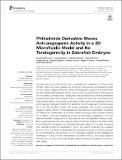Phthalimide Derivative Shows Anti-angiogenic Activity in a 3D Microfluidic Model and No Teratogenicity in Zebrafish Embryos
Author(s)
Kamm, Roger D.
DownloadPublished version (4.986Mb)
Terms of use
Metadata
Show full item recordAbstract
Angiogenesis is a crucial event for tumor progression and metastasis. It is the process through which new blood vessels are formed and has become a therapeutic target in many cancer therapies. However, current anti-angiogenic drugs such as Thalidomide still have detrimental teratogenic effects. This property could be caused by the presence of chiral carbons, intrinsic to such compounds. We synthesized four different phthalimide derivatives that lack chiral carbons in their chemical structure. We hypothesized that these achiral carbon compounds would retain similar levels of anti-angiogenic activity whilst reducing teratogenic effects. We tested for their anti-angiogenic functions using an in vitro 3D microfluidic assay with human endothelial cells. All four compounds caused a drastic inhibition of angiogenesis at lower effective concentrations compared to Thalidomide. Quantification of the blood vessel sprouting in each condition allowed us to classify compounds depending on their anti-angiogenic capabilities. The most effective identified compound (C4), was tested in vivo on a zebrafish embryo model. Blood vessel development was measured using number and lengths of the stalks visible in the fli1a:EGFP transgenic line. Potential teratogenic effects of C4 were monitored over zebrafish embryonic development. The in vivo results confirmed the increased potency of C4 compared to Thalidomide demonstrated by results in embryos exposed to concentrations as low as 0.02 µM. The teratogenic analysis further validated the advantages of using C4 over Thalidomide in zebrafish embryos. This study highlights how the use of in vitro 3D model can allow rapid screening and selection of new and safer drugs.
Date issued
2019-04Department
Massachusetts Institute of Technology. Department of Biological EngineeringJournal
Frontiers in pharmacology
Publisher
Frontiers Media SA
Citation
Mercurio, Annalisa et al. “Phthalimide Derivative Shows Anti-angiogenic Activity in a 3D Microfluidic Model and No Teratogenicity in Zebrafish Embryos.” Frontiers in pharmacology 10 (2019): 349 © 2019 The Author(s)
Version: Final published version
ISSN
1663-9812